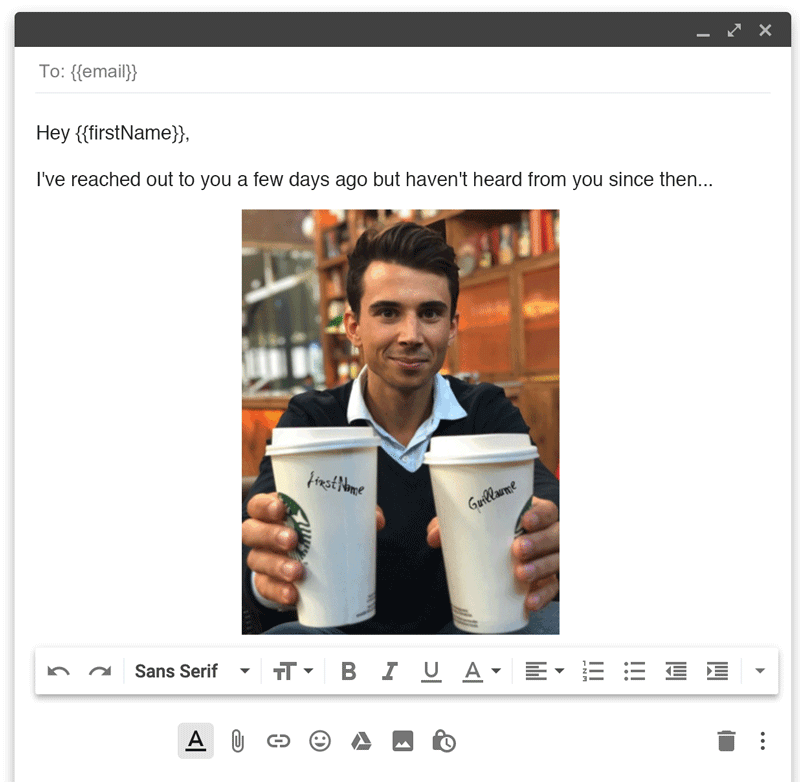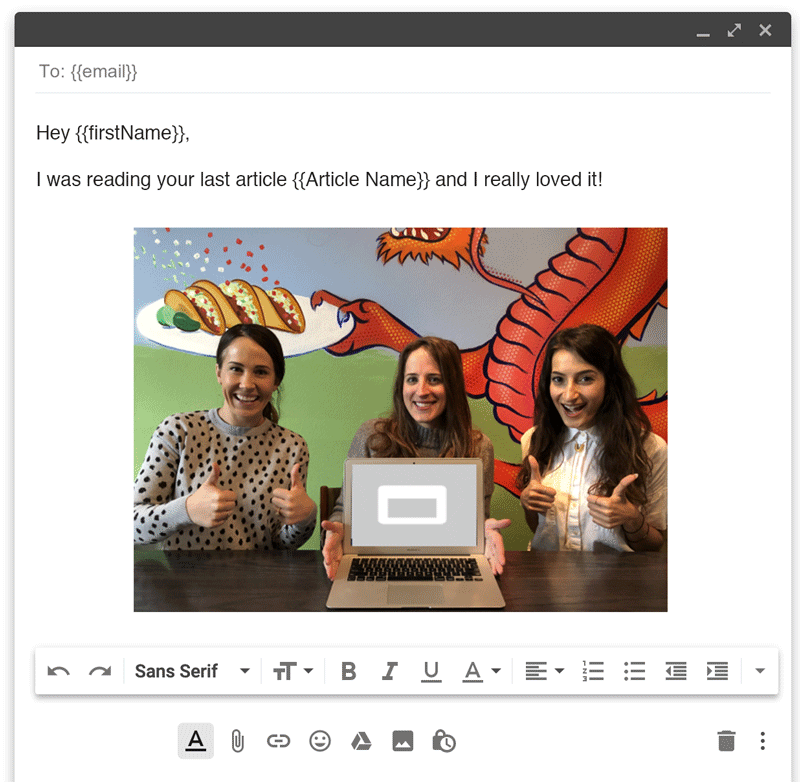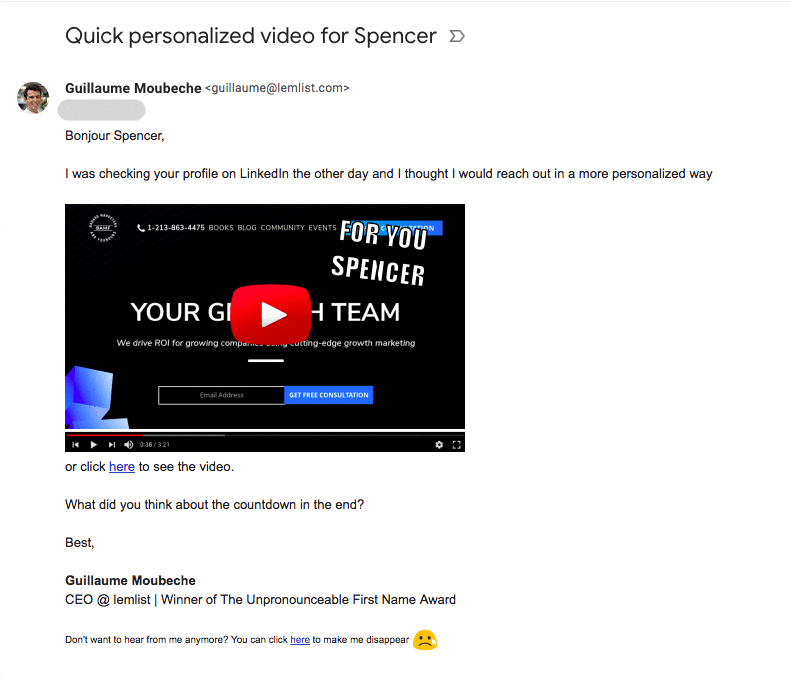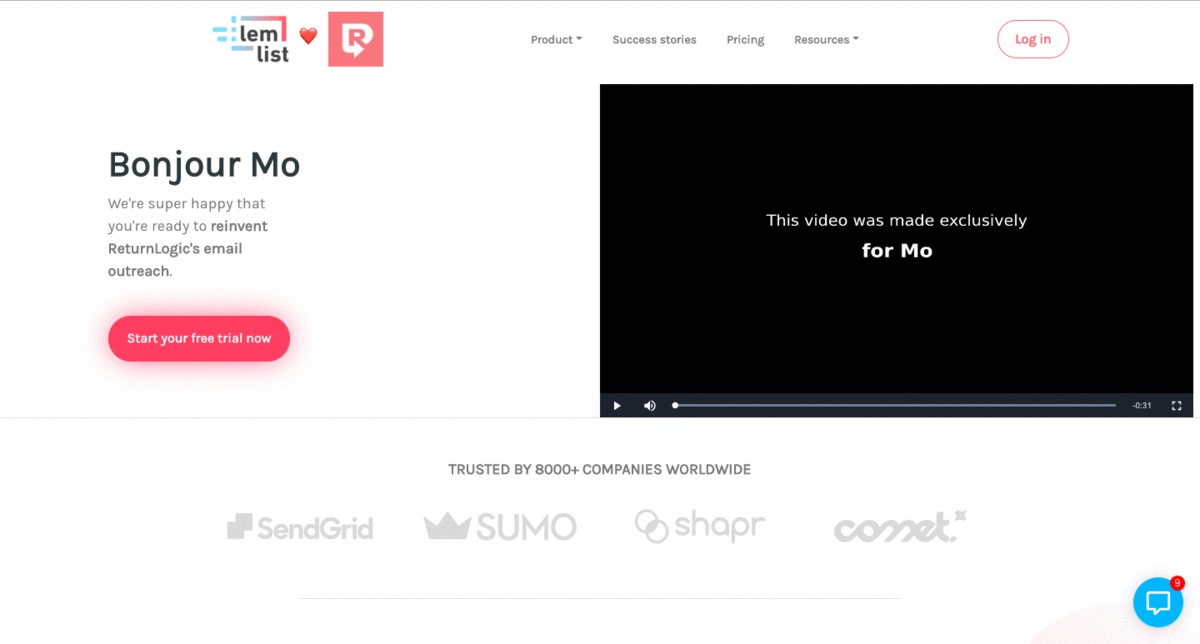365 days after launching lemlist, we finally reached the quarter of a million ARR (annual recurring revenue) milestone.
As a fully bootstrapped startup (with $0 in funding), reaching profitability as quickly as possible has always been our main focus.
Focusing on profit in a world where we often associate the success of a startup to the amount of money they’ve raised, is definitely a different approach yet it can give a different perspective to anyone trying to grow his business without raising funds.
In this article, I wanted to share our journey, without any bullshit and by giving our detailed process to grow lemlist including what worked and what didn’t.
TL;DR
- Growing a SaaS (Software as a Service) company in a very crowded market is definitely more difficult yet, it has some advantages
- Targeting Enterprise account was a waste of time in the early days
- Focusing on building our community and provide value to our users was clearly a win
- Churn is clearly a pain when targeting SMBs
- Price should always go up (even if you’re scared to increase it)
- Done is always better than perfect — high pace testing is key
- Always listen to your customers but never forget to also trust your guts
Ok… now that you’ve been reading this little intro let’s start with the numbers 💸
First of all, I’d like to clarify that the $250K ARR milestone is based on the MRR (monthly recurring revenue) and only includes customers who have subscribed to a monthly plan.
I’m not including in those numbers the different enterprise accounts that are paying in a different manner as I prefer being as conservative as possible.
Since we’re also running two other SaaS projects (talkus & lempod) I have excluded the MRR of those projects as well to only focus on lemlist.
So, what were our numbers 365 days after our launch:
- MRR: $20,833 (hence the $250K ARR)
- Average Month over Month (MoM) Growth on the MRR since inception: 33,19%
- Previous monthly growth on the MRR: 34,81% (the reason I’m mentioning this number is that an average MoM growth could be biased due to the fact that it’s much easier to grow by more than 30% in the early days when your MRR is very low…)
- Churn: Way too high so keep reading because I’ll discuss this in details below 😎
- If you’re wondering how our growth looks like check out the graph below👇

Let’s now start from the beginning in order to understand our growth process…
Validating our idea… fast!
When launching lemlist, I had just met with my 2 technical co-founders, 2 highly experienced SaaS developers who had clear goals in mind: Validate the idea as quickly as possible and determine whether or not we continue working on it.
Pretty harsh you might say but definitely a great way of thinking.
As Reid Hoffman (Founder of LinkedIn) once said: “If you’re not embarrassed by the first version of your product, you’ve launched too late.”
This how I felt at that time 😣 … so let’s say that we definitely didn’t launch too late 😂
If you want to learn more about how an inexperienced SaaS founder like myself convinced 2 technical geniuses to partner with him, make sure to check our story here.
As I mentioned in the TL;DR section, launching in a crowded market is definitely not what people usually advise… However, one of the advantages is that you don’t really have to validate the product market fit as others have done it for you in the past.
You just have to be better than competitors. Easy right? 😂
Not really… but at least there are some easy ways to test whether or not your idea is promising!
So, how to validate quickly your idea?
Product Hunt!
For those who don’t know Product Hunt, it’s THE best worldwide community to discover new tech products.
Launching on Product Hunt is a real test to see whether or not your product is bringing something different to the table.
For us, it was a real success as we ended up #1 product of the day which leads to hundreds of signups.

The only issue at that time is that our value proposition was exceeding what our product could deliver at that time 😅 (Oopsy).
Even though a lot of these users were “disappointed”, it was a great way for us to validate the need of people to get more replies to their email outreach.
It was also really interesting to see all the great feedback we had regarding our personalization technology.
After such a launch, we decided to work hard on the product based on feedback while preparing our AppSumo launch.
AppSumo is an online community of 1 million entrepreneurs and agencies who are offering Lifetime Deals to their community. Being on AppSumo can really give a huge boost in term of visibility and is a great way to launch a SaaS product.
You might think that giving a lifetime license to your product doesn’t make sense but if you want to learn more about our launch and the detailed numbers, make sure to read this article.
Even though we launched on Product Hunt we didn’t have any paying customers at that time as we decided to keep the beta free and wait for the AppSumo launch.
The AppSumo launch
Since I already wrote an article about that, I don’t want to go into all the details of this launch but essentially, we made $160K in two weeks (the offer was obviously limited in time).
Awesome you might say?
Well… it’s indeed a huge amount of money for such an early stage SaaS but the thing is that AppSumo took 70% of that deal 😱😱😱
So we ended up with approximately $50k….
I know… It’s a pretty huge share but since they own their community and they run a lot of ads for you during the launch, I still think it was worth it 😊
On top of that, because we were one of their top partner, they decided to invite me to Austin in order to help me on all the Growth and Marketing aspect of lemlist 😍
In essence, in two weeks, we had thousands of companies paying for lemlist and it was enough of a proof for us to believe that we were on the right track!
Since we’re clearly in a crowded market, having so many new companies using our product was a real blessing to start building a product people need.
During those 2 crazy weeks, we had to handle thousands of tickets while being a team of 3!
However, having all those conversations was definitely a huge asset in order to understand the pains and needs of our customers.
Based on all the feedback we started iterating super quickly on the product.
We also decided to leverage that huge user base to launch a community dedicated to email outreach on Facebook called The Email Outreach Family.
From the very beginning at lemlist, we’ve always believed that automation is key because you don’t wanna do the same thing over and over again, but never sacrifice personalization. Automate repetitive tasks so you can focus on human connections.
With that Facebook community, we essentially created a way to communicate directly with our users on a platform where people usually hang out with friends.
We also decided to be real with people without B.S. and talk to them as we’d be talking to our friends.
But creating such an open community was also an opportunity for us to make our first fail VERY public…
Since I think we get a lot of learnings from failure, I’ll start by discussing them below before detailing our growth process 😇
Fail #1 — New UX release
After the AppSumo launch, we decided to start billing people on a monthly basis in order to start growing our MRR.
However, we quickly realized that our conversation rate was not as high as expected… We had signups but only very few sales…
We decided to implement more behavioral tracking to understand what our users were doing and after checking all the data, we decided to focus on 3 metrics:
- Number of sign-ups
- Number of activated users (Number of users who signed up and launch a campaign on lemlist)
- Number of paid users
Based on those numbers we made the hypothesis that if our activation rate was too low it was because our platform was too complicated to use and that people were taking too much time to create campaigns…
Based on that assumption, we entirely rebuilt the platform and without warning our users, we decided to push the new version…
We were convinced that it was the right thing to do but when I think about it I realized how stupid it might sound 😅
Anyway… We all make mistakes and some of our users clearly showed their dissatisfaction when it comes to the new UX…


As a first time SaaS founder, I really felt bad at that time as we usually get on super well with our users and most lemlisters (lemlist user) are usually super friendly…
Luckily, my technical co-founders decided to put their robot mode ON and fixed all the different glitches that people were complaining about 😍
Within 24 hours we had entirely changed the perception of the new platform:

After a few weeks iterating on that new version, we realized that we actually improved our conversion rate from free trial to paid customer by 3x.
We also increased our activation rate by 4x and divided by 2 the time it takes to create a campaign!
In the end, communicating with your users prior to a huge UX update is key but in the end, trusting your guts even when it’s tough can really make a difference!
At that time we also decided to start spending more time with some enterprise accounts…
Fail #2 — Going after enterprise accounts too early
The AppSumo launch generated a lot of visibility leading to attracting some much bigger accounts than we expected…
I’m talking big names like Uber, Facebook etc…
However, when you want to start working with those enterprises you need to be ready for paperwork.
And when I say ready I mean….. Ready.
Basically, all those enterprises are asking for way too many documents and internal tests before actually committing to something…
Even though having such companies as customers is definitely great for branding, the complexity of such sales both on the technical aspect and business aspect was definitely a no-go on my end.
My mistake was to spend too much time on those accounts instead of being super focused on our target market.
But knowing what I didn’t want to do was also a great way for us to be much more focus on our core segment of startups and SMBs afterward.
Since apparently good things come in threes, let’s jump to the 3rd fail.
Fail #3 — Launching an affiliate program
I love affiliation!
I mean… at least I used to…
The concept is brilliant when you think about it… You ask people to bring you some new business and in exchange, they get a commission.
I’ve always been up to sharing money with people bringing business or value so for me, affiliation did make a lot of sense especially with the thousands of customers we had from the AppSumo launch.
In our case, we decided to be super generous on the affiliate program and give 30% revenue share to all the persons who were bringing some new customers.
At first, the affiliate program was a fail… so I decided to start investing a bit more time on it and find better affiliates.
However, when our growth started being significant I started to see great traction from our affiliate program…
I was pumped!
But during my trip to Sri Lanka, I realized that when I was typing lemlist on Google I had a sponsored link on the first search result…
Knowing that we’ve never done paid ads in the past, I knew that something was off… After clicking on the link I realized that one of our partners was actually buying our name on Adwords 😱
Essentially, he was “stealing” most of our organic traffic that way…
Facing this issue I decided to investigate all of our most successful partners and I realized that 2 of them were bidding on our names on Adwords and that others were creating different accounts via their affiliate link to get what would be equivalent to a 30% discount 😞
I’m using the sad emoji face to be polite but inside, this is how I felt 🤬
After this fail, I decided to put an end to that program as I really didn’t want to spend time checking each and every one of our partners to know whether or not they’ve been cheating the system…
Actually… good things don’t come in threes but in fours so let’s get straight to another fail…
Fail #4 — Keeping a low churn
This is probably the most well-kept secret of any companies…
Churn rate!
The number of SaaS companies lying about churn or who simply never mention it is huge…
Which makes it super hard for you to compare whether or not you’re on the right track or not…
Obviously, churn depends on your market and on your target audience.
Since we’re on a highly competitive market and targeting SMBs our churn has been way too high.
Obvisouly it has not been an issue to grow since we’re still growing at a 33% MoM growth rate, but it’s a pain because we could make more money with a lower churn 💸
So, how’s our churn at lemlist?
The first thing is that we need to differentiate two things:
1- Gross MRR Churn: “the percentage of revenue lost due to cancellation or downgrades”
2- Net MRR Churn: “the measure of lost revenue month over month (due to cancellations and account downgrades) after factoring in any revenue from existing customers (i.e. upgrades/expansion)”
Our Gross MRR Churn evolved from 17% to 8% 😱😱😱
I know… that’s really high.
However, our Net MRR churn evolved from 10% to -2%. A negative net MRR churn rate means that the revenue generated by people upgrading (adding more seats or changing plan in our case) is higher than the revenue lost by actual customer churning.
To be honest, every time I saw a user churning it was breaking my heart 💔
And since our mindset was to allow people to cancel whenever they want, we didn’t gather any information about the reason why (stupid you might say… Correct!)
So, we decided to implement a few things to know why our users were churning.
The first step was to add some human touch - as I will discuss below in the different pillars of growth, one of the keys of our success is the human factor - in order to connect with our users before they leave.
Once they hit the cancel my subscription button, a popup where they could choose the person that will take a "pay cut".
Once they would select one of us, they will have to give us the reason before actually being able to cancel their subscription:

After selecting a reason or writing some information we directly get a notification into Slack to understand why:

Having pieces of information in real time was key to identify the main reasons why people were churning in order to find solutions to each issue.
For example here:

Sometimes, people don’t get new business using cold emailing. Usually, it’s for two reasons:
1- they didn’t address the right target
2- they didn’t have the right message
Based on that we were able to get in touch with our users and review their email templates and strategy to help them become more successful! Which ultimately lead to more businesses.
Another interesting part about churn is that, after talking with some very successful companies, I realized that a lot of people don’t calculate their Churn rate the way we do (We use both Profitwell and Chartmogul so it’s calculated automatically).
Essentially, most companies are calculating their churn with some conditions.
For example, they will calculate the churn based only on users who are staying for more than 3 months.
After trying this approach, our churn drastically decreased but I felt like I was cheating so I prefer using the traditional approach 😊
In any case, it doesn’t matter how you calculate your churn in the end, what matters is to always decrease that number over time.
Knowing that you probably decided to read this article because of the catchy tagline, let’s start talking about how we built our growth engine at lemlist 😇
Building a growth engine
As mentioned, at the beginning of this article, achieving an average of 33,19% Month over Month growth on our MRR without any funding was the result of a lot of experimentations and testing.
Essentially, we divided our growth process into 7 pillars
1- Growing your audience, make friends and be kind
2- Use your product, make love to it and tell everyone about it 🇫🇷 🥖
3- Give birth to a baby product, teach him how to walk and talk like a real human being
4- If you don’t write content you’re dead…
5- Sharing love and knowledge everywhere
6- If you want more money, simply ask for more
7- Know your users better than you know yourself
1- Growing your audience, make friends and be kind
I know that some part of this title might sound unusual and somehow intriguing so let me explain…
At lemlist, we’re passionate about what we do — period.
I’m not gonna sell you a story saying that; when I was a baby I used to send a lot of cold emails without getting any replies so I realized that we had to build something great and that my only purpose in life became to build lemlist.
No… That wouldn’t be true and as I said, there won’t be any BS in this article…
We’re passionate about what we do because we love to help people being more successful in what they do!
I’m detailing this specific point because it’s part of our DNA and in my opinion, it was key to our success…
But for now, let’s get back to our growth engine!
As mention above, right after our launch, we decided to start building a community called “The Email Outreach Family” on Facebook.
The reason we chose that name is that we consider all lemlisters as part of our family.
lemlist is our baby and we need to make it grow all together.
From the beginning, our mindset was to have a strong focus on the product and to be super close to our users.
Thanks to my two technical co-founders, we were able to implement changes in the app at a crazy speed and all of the community was super pleased to feel listened and valued.
Very quickly I understood that a happy lemlister was a lemlister who would get great results with lemlist (pretty obvious I know 😅)
From that point and because I was spending a lot of time either on the chat or on our community on Facebook, I started getting super close to many of our users.
Since my goal was to help them become successful, I became friend with many lemlisters all over the world!
Every feedback we receive is always taken very seriously and we make sure to inform each lemlister as soon as something he requested gets implemented.
Because I know that saying things like “provide value” or “help people being more successful” can be a little abstract, here two examples of something we started doing to help our users:
A- Email warm-up and deliverability
The first one came directly from the community itself… essentially, when sending cold emails, your deliverability (meaning whether or not your email was delivered into the inbox) is key.
One of the issues people face when their domain is new is that they need to “warm-up” their email domain before actually being able to send cold emails.
Essentially the warm-up process consists in sending manual emails to friends and increase the number of emails you send every day. If you’re interested in that topic, check out the most extensive guide about email deliverability and warm-up.
One of our power users decided to post something about that in the community:

Based on the reactions and comments, we decided to have people join a waitlist for a new feature we wanted to develop to do that automatically.

In 24 hours we had 100s of people putting their email address on the Google Sheet to have access to that feature.
Knowing that we have thousands of users all over the world, our email warm-up feature would definitely be the best ever created because of the different type of email providers, locations and domain age from all the current lemlisters.
After having my co-founders put their robot mode ON one more time, we shipped that new feature after a week and the results were simply amazing

All the comments and reactions we received were super supportive of the new idea 😎

The great thing about building a community is to be able to get feedback instantaneously about what you’re doing. In that case, we managed to tackle a pain that no one in the industry thought of in years…
B- Getting more replies to your cold emails
Using the same user-based approach, we realized that a real pain for most lemlisters was to get more replies to their cold emails…
Since I’ve been in that space for a bit of time and I’ve been testing things like crazy, I decided to launch every week a new successful email template that they could use and reproduce.
Since most cold emails are the same, lemlist allows adding an extra layer of personalization by adding personalized images inside your cold emails to make them stand out and get more replies.
Here is an example with some dynamic text on a cup of coffee:

And another one using lemlist technology to take screenshots automatically based on a URL or on the domain of the email address:

Those Gifs are essentially made to make people understand the power of image personalization while all the templates are fully available in our cold email template section.
As mentioned above, finding out that those templates were successful, required a lot of testing so let’s start talking about the second phase…
2- Use your product, make love to it and tell everyone about it 🇫🇷 🥖
First of all, I’d like to apologize for that dirty analogy but well… I got to keep you awake as it’s a pretty long read 😅
Giving you the advice to use your product is not something new yet I see a lot of founders who are not doing it for some weird reasons…
Don’t be that person and use your product!
Anyway, for us, I think that something that really pushed us to use our product is that I’ve always been a french cheap bastard 😂
Having a tool that I can use for free to do my sales prospecting was definitely a no brainer especially since it’s also a great way to test many different things and see what’s working… or not!
I mentioned how important fast pace testing is and that’s exactly what we did with our platform.
Thanks to email outreach we got in touch with enterprise account in the Silicon Valley testing new approaches and verticals and also closed some really cool companies.
Every time I was testing something new, and the results were good, I was writing about it.
One of my articles even got featured in a Medium blog with 40K followers called Noteworthy — the journal blog.

Detailing the step by step process about how I used lemlist to achieve some great results was one of the best ways to illustrate to our users what they could do.
At the same time, it was also a great way to generate traffic and have people signing up for lemlist.
Using our product and experimenting new things was also key to build new features bringing a lot of value.
At lemlist, we strongly believe that personalization is key especially when you’re trying to build relationships with people who have probably never heard of you.
Based on our assumptions we started to implement personalized videos and landing pages very early in our process.
Since we can generate personalized images based on the person’s email address (adding automatically company logo, website screenshots, first name etc…) we tested this process of adding a personalized video in an email driving to a personalized landing page:
Personalized email with dynamic clickable image

Dynamic and personalized landing pages

Based on some crazy results we had, we decided to implement it for Zendesk and their success was huge as well!
The reason I’m saying that is not to brag about it but more to explain that we started doing something in a semi-manual manner as a test and once we saw the potential we started testing it with some other companies.
Based on some great results and success story, we decided to entirely automate that process and build within lemlist a feature allowing to generate personalized landing pages.
Which was also a game changer and has been very appreciated by the community 😍

3- Give birth to a baby product, teach him how to walk and talk like a real human being
After using the product like crazy I clearly realized that our baby was missing a soul…
When you look at most B2B (business to business) companies, you quickly realize that most of those companies tend to be “boring”…
However, a lot of boring companies are full of super cool and fun people!
So why that? I think that most people think that, business, is by definition not meant to be fun…
At lemlist, we believe the exact opposite!
B2B doesn’t have to stand for boring-to-boring
And because it’s also part of our DNA we decided to give a soul to our product.
A- From “leads” to buddies-to-be:
We’ve all been there… Talking about contacts, prospects, leads, qualified leads etc…
For us, all this terminology is totally dehumanizing the relationships you want to build with the persons you’re reaching out to.
Because we believe that we do business with people we like value and trust (a bit like friends in the end), we decided with my friend Charlie (who actually came up with that idea) to change the terminology to buddies-to-be.
B- Making stats human and Sexy

We all know that each action (opens, clicks, replies etc…) has an impact on the success of your campaigns… In order to make your buddies to be more human, we’ve decided to associate each of their action to a specific emoji showing an emotion 😍
C- From Unsubscribe to Graveyard

Well… It’s Okay… You can’t become friends with everyone… That’s actually why we’ve renamed the unsubscribe section… Graveyard 😱
I know it’s a bit scary… But well… You know… If they don’t want to hear from you it’s cool ❤️
D- Creating a 100% human onboarding
In order to make every single lemlister feel welcomed and in good hands we created an onboarding sequence using lemlist including videos and personalized images.

The results of this onboarding campaign were a key factor in improving our activation and conversion rate.

Which such a high click rate we were able to drive some more traffic to our website while at the same time building a relationship with our users.
At the same time, we decided to add automatically each user who would sign up to lemlist on LinkedIn with a custom script.
Adding people on LinkedIn with a friendly welcoming message is the best way to get insights for us.
The message:
Bonjour {{firstName}},
I’d like to personally welcome you to the lemlist family ❤️
How did you hear about lemlist?
The type of insights we get on a daily basis:

With such messages I’m able to start daily conversations with a lot of new lemlisters all over the world and to be honest it’s been one of the best way for us to really get to know our users and their needs 😍
4- If you don’t write content you’re dead…
Well… This one might sound a little bit harsh and I know companies that are doing 0 content and that are doing really really well!
However, in our case, writing content has been key for 3 reasons:
- It was a great way to educate our users on some complex topics such as email deliverability, account warm-up etc…
- We were able to write highly valuable and ready-to-use content such as our cold email templates collection.
- Each content was also repurposable on many different channels
When I meet with other founders, a very common issue I see people facing is to find the right content to write about.
In my opinion, I think that the best way to find content was to listen to our users and market…
Sounds difficult but if you spend time talking to your users on the chat you’ll quickly understand that some common topics often come up…
Let’s take one example here:
People were always wondering how to find email addresses or even how to get the best deliverability possible…
After spotting these topics we decided to spend some time finding the best keywords to use (using tools like Ahrefs, Ubersuggest etc…) in order to create an article that was optimized for search.
More than just optimizing the content for search we also decided to write the best content out there with some unique and undiscovered techniques.

As you can see, this article is 16 minute long so we wanted to detail the step by step guide on how to find anyone’s email address.
If you look at the article, you’ll see that the goal is to only give value and actionable tips.
You’re probably wondering why we want to rank for such keywords when our tool is actually a cold emailing platform?
Well… people who want to find email addresses for sales prospecting often need a tool to send emails in a personalized way, hence lemlist!
In every industry, you can find topics that will bring benefit to your users while at the same time position yourself as a thought leader.
That’s also what we did with the deliverability topic.
Since our combined users have sent 10s of millions of emails across more than 10 000 accounts, we had a lot of data to know what was working or not.
Based on that we analyzed all the best practices and decided to write another in-depth guide about email deliverability and account warmup.
However, content creation is only 20% of the work…
The 80% will come from content distribution and repurposing and that’s actually our 5th pillar 🤩
5- Sharing love and knowledge everywhere
Another intriguing name for a growth pillar you might say!
Worry no more my friend, this part is about repurposing content.
In the early days, it was just 2 developpers and a random French guy (me 👋 🇫🇷).
However, this content strategy of documenting every single thing we were doing attracted a rising star… Vuk 🤩

After giving him a shot, Vuk directly showed me his thirst to strive and I really liked his hustle mindset.
A few months after that we were meeting in Paris to build this 5th pillar:

The concept is pretty simple. We’re a small team with great ambition.
Being small means that we wouldn’t be able to produce hundreds of articles every single month.
However, each article can be repurposed and share on many different communities or media.
We divided our strategy in 2:
A- Repurposing content on multiple platforms
This might sound pretty easy yet most companies forget about it…
For example, let’s say that you record a video about 10 tips about cold emailing.
You can now transform this one video into 10 and write posts about it on LinkedIn.

That’s actually what we did.
Giving weekly tips around a specific topic.
By dividing into pieces a content you usually make it much more digest, especially on social platforms.
Another example where Vuk really killed it was to repurpose some articles on Quora by answering a lot of questions related to our area of expertise.

After repurposing each and every single piece of content, we were able to drive traffic from various sources and define what was working or not.
I know that most people would advise focusing on one channel but in our case, we did the opposite and it worked pretty well so… sometimes you just have to do you 😊
B- Sharing content everywhere we could bring value
This part is often called content distribution and that’s exactly what it is in the end.
There is no secret as you need to find facebook communities where your audience hangs out and give them the content they like.
It can be on Facebook communities, Slack groups or even online forums such as Growth Hackers were we got featured in their newsletter a few times already:

Based on the great results of those test, we decided to implement a much more thorough process when it comes to content that I will probably detailed in another article 😎
6- If you want more money, simply ask for more
As a first time founder, I think that was the scariest thing to do…
Increase price…
Everyone talks about it and it sounds pretty magical… ‘You want more money? Well… increase your pricing! It’s obvious’
Every time I had that conversation I felt stupid… I even recommended to many other founders to increase their price! But when it comes to lemlist I chickened out…
What if people don’t want to pay that amount of money?
What if people find it too expensive?
In the end, it’s only a matter of perceived value…
A higher price means more value.
Because we postponed for a long time that price increase, we decided to increase our pricing by 50%.
Yup.. 50%…
But guess what? In the end, it was our best month! Our growth increased and our conversation rate stayed the same 🤩
So if you feel scared right now, don’t be… We’ve all been there and it will be fine!
7- Know your users better than you know yourself
Being user-centric is something any marketer has heard of.
To me, it’s not only about being user centric. It’s also about getting to know your users even better than yourself!
To do so, we decided to run some user surveys using lemlist.
The goal was to get to know our paid users who have been supporting us since the early days and understand what they liked or disliked.
Regarding the survey, we decided to use what Rahul Vora did for Superhuman.
4 questions to get the best insights:
1. How would you feel if you could no longer use lemlist?
A) Very disappointed
B) Somewhat disappointed
C) Not disappointed
2. What type of people do you think would most benefit from lemlist?
3. What is the main benefit you receive from lemlist?
4. How can we improve lemlist for you?
Getting enough replies to a survey can really be a pain however, we decided to apply the exact same best practices when it comes to email outreach — personalization at scale!

Let’s say that those results were beyond our expectations!

Once our users clicked on the video, they would be redirected directly to a personalized landing page including the Typeform survey.

Each landing page was automatically personalized using lemlist technology.
In total, we had almost 100% conversion rate from click on the video to survey completion.
It was also a great way to illustrate some of our latest features with lemlist 😎
In the end, we had the following results to the first question “How would you feel if you could no longer use lemlist?”:

Based on those results we were able to really split our customers into buckets and understand two things:
1- who are those users who would be “very disappointed” if they couldn’t use lemlist anymore.
→ Essentially you want to focus on that segment in order to find more people who will find your product indispensable.
2- Why are some users only “somewhat disappointed”
→ For that segment, the goal is to understand how you could move them towards the bucket number 1 of your power users.
Having such insights was really of huge value to keep getting to know our users even more and that’s definitely a survey that needs to be run multiple times each year.
What’s next for lemlist?
After such an exciting start, our goal is to keep growing at the same pace while keeping a “small” and agile team.
We also want to focus more and more on our user’s need so we’ve decided to hire Ena as our customer champion while Vuk’s goal in the next quarter is to make lemlist rank on the first page of Google for a defined set of keywords 🚀
Another goal is to keep experimenting at the same pace while linking the tech team and the growth team to do twice a months growth sprints (I’ll probably write about those in a few months).
Love you all guys ❤️
P.S: Sharing is caring 😘



